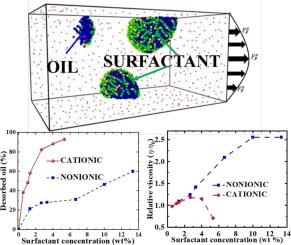以阳离子和非离子表面活性剂包封的烃类分子流动解吸作为提高采收率的模型
IF 5.2
2区 化学
Q2 CHEMISTRY, PHYSICAL
引用次数: 0
摘要
由于碳氢化合物在岩石表面的强烈吸附,提高成熟油藏的采收率仍然是一个关键的挑战。注入表面活性剂提供了一种从表面解吸油分子的可行策略。本文采用非平衡、中尺度的数值模拟方法,研究了不同吸附强度的离子和非离子表面活性剂对模型表面吸附碳氢化合物的解吸作用。介绍了一种由轻烃分子和重烃分子组成的石油分子精细模型。评价了离子表面活性剂和非离子表面活性剂在不同浓度下的解吸效果。从模拟中提取了粘度,发现非离子表面活性剂比阳离子表面活性剂在体系中产生更高的粘度。结果表明,离子表面活性剂通过形成多层结构,将碳氢化合物包裹成球形聚集体,从而实现了优异的脱附效果,从而降低了接触面积,降低了粘度,提高了萃取效果,即使在低浓度下也是如此。相比之下,非离子型表面活性剂形成单层,将碳氢化合物分解成更小的聚集体,增加了体系粘度,阻碍了萃取。预测了两种表面活性剂的解吸等温线随表面活性剂浓度的变化。这些发现为提高采收率的表面活性剂的设计和选择提供了分子视角。本文章由计算机程序翻译,如有差异,请以英文原文为准。

Desorption of hydrocarbon molecules encapsulated with cationic and nonionic surfactants under flow as a model for enhanced oil recovery
Enhancing oil recovery from mature reservoirs remains a critical challenge due to strong adsorption of hydrocarbons onto rock surfaces. Surfactant injection offers a viable strategy to desorb oil molecules from surfaces. Here we report nonequilibrium, mesoscale numerical simulations under stationary Poiseuille flow to investigate the desorption of adsorbed hydrocarbons from model surfaces with varying adsorption strengths with ionic and nonionic surfactants. A novel, molecularly detailed model for oil is introduced, made up of light and heavy hydrocarbon molecules. The desorption efficacy of ionic and nonionic surfactants is evaluated across different concentrations. The viscosity is extracted from simulations and it is found that the nonionic surfactant induces higher viscosity in the system than the cationic surfactant. The results show that ionic surfactants achieve superior desorption by forming multilayer structures that encapsulate hydrocarbons into spherical aggregates, leading to lower contact area, lower viscosity and enhanced extraction, even at low concentrations. In contrast, nonionic surfactants form monolayers that fragment hydrocarbons into smaller aggregates, increasing system viscosity and hindering extraction. Desorption isotherms as functions of surfactant concentration are predicted for both surfactant types. These findings provide molecular insights to guide surfactant design and selection for enhanced oil recovery applications.
求助全文
通过发布文献求助,成功后即可免费获取论文全文。
去求助
来源期刊

Journal of Molecular Liquids
化学-物理:原子、分子和化学物理
CiteScore
10.30
自引率
16.70%
发文量
2597
审稿时长
78 days
期刊介绍:
The journal includes papers in the following areas:
– Simple organic liquids and mixtures
– Ionic liquids
– Surfactant solutions (including micelles and vesicles) and liquid interfaces
– Colloidal solutions and nanoparticles
– Thermotropic and lyotropic liquid crystals
– Ferrofluids
– Water, aqueous solutions and other hydrogen-bonded liquids
– Lubricants, polymer solutions and melts
– Molten metals and salts
– Phase transitions and critical phenomena in liquids and confined fluids
– Self assembly in complex liquids.– Biomolecules in solution
The emphasis is on the molecular (or microscopic) understanding of particular liquids or liquid systems, especially concerning structure, dynamics and intermolecular forces. The experimental techniques used may include:
– Conventional spectroscopy (mid-IR and far-IR, Raman, NMR, etc.)
– Non-linear optics and time resolved spectroscopy (psec, fsec, asec, ISRS, etc.)
– Light scattering (Rayleigh, Brillouin, PCS, etc.)
– Dielectric relaxation
– X-ray and neutron scattering and diffraction.
Experimental studies, computer simulations (MD or MC) and analytical theory will be considered for publication; papers just reporting experimental results that do not contribute to the understanding of the fundamentals of molecular and ionic liquids will not be accepted. Only papers of a non-routine nature and advancing the field will be considered for publication.
 求助内容:
求助内容: 应助结果提醒方式:
应助结果提醒方式:


